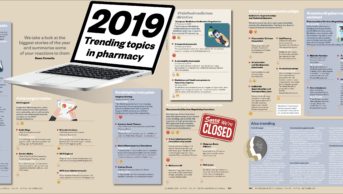The pharmacy profession has travelled a bumpy road in 2024, leading pharmacy teams into a state of uncertainty as the year ends.
Community pharmacists have become familiar with the ongoing pattern of pharmacy closures and 2024 was no different. NHS data show a net loss of 432 pharmacies in England in 2023/2024, but an investigation by The Pharmaceutical Journal in March painted an even more concerning picture, when we revealed that more than one-fifth of the remaining pharmacies have had to reduce their opening hours, which Community Pharmacy England (CPE) attributed to “the continuing financial squeeze on the sector”.
The financial situation was only made worse by the new government’s first autumn budget in October, which committed to increasing National Insurance contributions and national living wage, resulting in £200m additional annual costs for community pharmacies.
This is money that community pharmacies cannot spare. Pharmacies in Scotland have faired the best out of the three nations in Great Britain, securing an additional £13.2m for 2024/2025. However, Welsh pharmacies saw their funding frozen for the financial year, while pharmacies in England are still in the dark about any form of renewed contract, both a result of the timing of the general election in July.
With contractors left uncertain about how they will continue to run their businesses in 2025, it is unsurprising that they are now opting to leave patients in limbo too
With contractors left uncertain about how they will continue to run their businesses in 2025, it is unsurprising that they are now opting to leave patients in limbo too. A ballot of National Pharmacy Association members in all three countries, carried out in September, resulted in 99% voting in favour of limiting their service offering in early 2025 if improved funding is not forthcoming.
While the election threw community pharmacy contract negotiations into disarray, it helped settle those involving hospital pharmacists. Less than one month after his appointment, health secretary Wes Streeting granted NHS Agenda for Change staff a 5.5% pay uplift for 2024/2025. But the coming financial year looks less plentiful for hospital pharmacists, with the government only planning to offer them a 2.8% uplift in 2025/2026.
Such a pay rise would be hardly sufficient compensation for the stressful work environment in which these pharmacists find themselves. The Pharmaceutical Journal’s salary and job satisfaction survey results for 2024 revealed that 64% of 397 hospital pharmacists consider themselves moderately or very stressed, with one-quarter of them accessing mental health support as a result. Sources of stress in this sector are tightly linked, with 85% citing lack of staff as a source of stress, while 79% said stress came from high patient demand.
A bolstered NHS workforce would clearly go some way here, but the government has announced plans to “refresh” the workforce plan that was only just published in 2023, with “a laser focus” on shifting care from hospitals into the community. What this means for hospital staff though, is unclear.
Research suggests that primary care pharmacists’ presence is linked to lower prescribing rates and greater patient satisfaction
Progress for primary care pharmacists is clearer over the past year and highlights the great things that can be achieved when pharmacists are given the time and opportunity to flex their skills. Research published earlier in December suggests that their presence in GP practices is linked to lower prescribing rates and greater patient satisfaction.
Danny Bartlett, clinical lead at Kent, Surrey and Sussex Primary Care School and a member of the Royal Pharmaceutical Society’s English Pharmacy Board, says the findings are linked to primary care network (PCN) pharmacists having roles that “allow them to question why patients are prescribed inappropriate medications and deprescribe them where possible”.
As the least stressed of the three sectors, according to our salary and job satisfaction survey, PCN-based roles are attracting growing interest from pharmacists, with the number working in this setting increasing by 50% over the two years to October 2024.
The role of PCN pharmacists should give others — particularly those in community — some hope for 2025, following a challenging 2024.
Although PCNs currently have the largest proportion of prescribing pharmacists, 2025 marks the first year of training a new cohort of pharmacists who will become prescribers when they register in 2026. This will create a significant appetite to expand pharmacist prescribing services that are now being offered in all three GB nations, now including England.
Pharmacists should have more time to dedicate to these services with important changes to the role of pharmacy technicians and the changes to hub-and-spoke dispensing legislation that will likely be enacted in 2025. Thus, giving all pharmacists the same skills and comparable freedoms to provide the patient-facing care they want to provide.
While this is all easier said than done, amid several issues still to resolve in pharmacist training and logistics to consider in setting up hub-and-spoke dispensing, it is important to remember that even though the landscape is challenging, opportunities still abound. PJ
You may also be interested in

Research, CPD and Learning: 2022 in review

2019: trending topics in pharmacy

